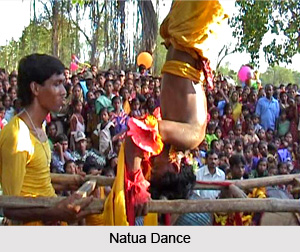 Culture of South Dinajpur district in West Bengal, as of any other place, is found contained in the art, architecture, literature, traditions and customs which are typically practised by the people residing in that place. These practices are handed down through successive generations, and they seek to preserve and protect the history and traditional legacy of the land. The South Dinajpur district too has its own typical culture, seen in the form of dances, dramas and various other theatrical performances and street plays. These are briefly discussed below.
Culture of South Dinajpur district in West Bengal, as of any other place, is found contained in the art, architecture, literature, traditions and customs which are typically practised by the people residing in that place. These practices are handed down through successive generations, and they seek to preserve and protect the history and traditional legacy of the land. The South Dinajpur district too has its own typical culture, seen in the form of dances, dramas and various other theatrical performances and street plays. These are briefly discussed below.
Khan Song
A folk form unique to the Dinajpur region is that of `Khan`. It is an age-old folk-cultural form practised by the rural people of the district - mainly belonging to the scheduled caste and scheduled tribe communities. It is a performance intermingled with song and dialogues. Khan deals with any local scandalous incident or illicit act committed by any local person. Some pundits interpret Khan as scandalous events. It is held in the Bengali language, in the form of the local dialect. Initially the songs were composed and set to music by the participants themselves. Nowadays, anyone from the team, who is capable enough, takes the responsibility of the same. Songs and dialogues are improvised, hence the lack of written manuscripts. Khan performers are mostly concentrated in Kushmandi and Bangshihari Blocks. The performances take place in the open and continue from late evening to the wee hours of the morning. Nowadays, the Khan teams and players are scattered all over the district, and there is seen an increasing number of professional Khan teams as well. Their performances are seasonal and they mostly take place after the harvesting season is over and the rural folk have money in their pockets. Some of the notable Khan palas are `Cyclesari`, `Budhasari`, etc.
Natua Dance
Natua dance is practised in some villages in the Kushmandi Block, and it deals mainly with the love of Radha and Lord Krishna.
 Jang Gan
Jang Gan
Jang Gan are Folk songs composed in Dinajpuri and Surjapuri Dialect. Gangarampur and Kumarganj Blocks have artistes of Jang Gan.
Mask Dance
Mokha Dance or Mask dance is practised by the rural people representing various ethnic groups. Masks are made locally using locally available wood. Kushmandi Block is the main centre at present. Masks of animals like monkey, tiger and Gods and Goddesses such as Goddess Kali, Lord Shiva, and also of some fictitious comic characters like Bura-Buri are made. Male dancers wear these masks with suitable attires and perform. The dancers are accompanied by drummers and local flute players.
In the Halna-Halnani the main characters are two fictitious rural persons - the male Halna and the female Halnani. This is a folk-opera type performance. Folk artistes of this district are socially conscious. They take part in all the Government programmes for social upliftment such as DPEP, Literacy Campaign, Health Awareness programme, Family Welfare programmes organised by the State Government.
Folk Cultural performances take an important position in the annual Teesta - Ganga Utsav (a cultural festival organised by the ICA Dept) where these folk artistes share the stage with artistes from the banks of the Ganga River. Baul songs, Lalon Geeti Bhawaia, Chatka, Gambhira are also practiced widely in this district. Songs of these Folk cultural forms are typical of neighbouring districts (Gambhira in Malda; Bhawaiya in Cooch-Behar) and the Bauls of Bengal are seen performing throughout the district. A Baul Mela and Utsab is held at Nayabazar Hattola in Tapan Block. Folk-cultural artists and performers now have a forum in the District, a sort of state level organisation.
The other notable folk cultural forms of the district are Bislihava, Saitpir, Jalmanga Gan, Khaja Gan and Chorchunni.






